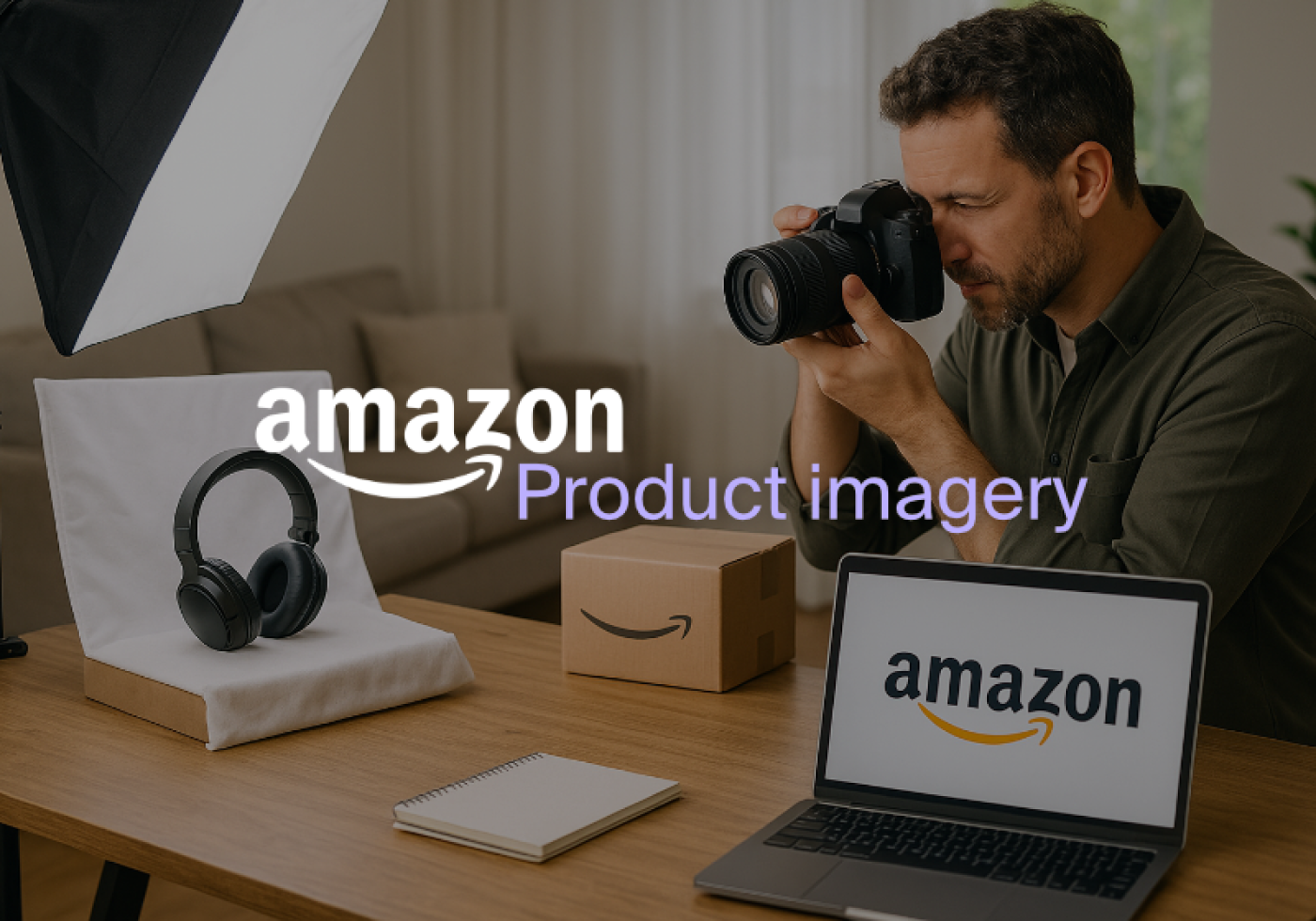Images are the most influential part of your Amazon product listing. Shoppers scroll fast, compare visually, and often decide to click—or not—within seconds. If your photography is poor, generic, or unclear, even a great product with glowing reviews can be overlooked.
This in-depth guide explains what Amazon requires for product images, what makes photos truly effective, how images vary across categories, and how to create or update your visuals to increase conversions. Whether you’re launching a new product or improving an existing one, understanding the role of imagery is essential to long-term success on Amazon.
What does Amazon require for product images?
Amazon has strict image requirements for its marketplace, especially for the main image (the first photo shown in search results).
Here’s what Amazon expects:
Main image requirements:
- Must be a professional photo of the actual product (no renders or illustrations)
- Must be on a pure white background (RGB 255, 255, 255)
- Must fill 85% or more of the image frame
- Must not include text, logos, watermarks, borders, or additional graphics
- Product must be clearly visible (not cropped, blurry, or overly stylised)
- File must be JPEG, TIFF, GIF, or PNG and at least 1000px on the longest side (to enable zoom)
Additional image rules:
- You can upload up to 9 images, but Amazon shows 7 by default in most categories
- Lifestyle images, infographics, and packaging images are encouraged
- Images must accurately reflect the product being sold
- No misleading images, offensive content, or props that distort reality
Amazon may suppress your listing if these rules aren’t followed, so this isn’t optional.
What makes great Amazon product photography?
Compliant images are the baseline—but great images help you sell. A strong image set tells a story, overcomes buyer objections, and drives confidence in the purchase.
A fully optimised listing should include:
- A clean white background main image
- A lifestyle image showing the product in use
- A feature close-up (e.g. fabric, stitching, control panel)
- An infographic explaining key specs or benefits
- An image of the packaging or what’s included
- A photo that shows product size (in hand, next to common object)
- An instructional image explaining usage or installation
Each image has a job. Together, they reduce customer hesitation and increase conversions.
Photography by product category: Why it matters
Your image strategy should be tailored to your category. Here’s how it varies:
Home & Kitchen:
- Use styled lifestyle photography to show how the product fits into real homes
- Highlight scale by placing items in context (e.g. on a dining table or countertop)
- Zoom in on textures, materials, and finishes to show quality
Beauty & Personal Care:
- Clean, well-lit white background shots are essential
- Use close-ups to show packaging detail and applicators
- Lifestyle photos should reflect the buyer demographic and setting (e.g. bathroom vanity)
- Consider including before-and-after or benefit-focused infographics
Toys & Baby:
- Safety and softness should be visually obvious
- Use photos showing children or parents interacting with the product
- Add images that communicate packaging and gift-readiness
Apparel & Fashion:
- Always include model photos from multiple angles
- Use a size guide image to reduce returns
- Use lifestyle imagery to reflect the target customer’s look and style
Tools & Hardware:
- Show the product in use—cutting, assembling, fixing, etc.
- Use infographics for key specs like power, size, and materials
- Close-up shots should show quality and ruggedness
Photography should reflect both the product’s function and the buyer’s lifestyle.
The importance of images during a product launch
During the “honeymoon period” of a new listing, Amazon is watching. Your early clicks, conversions, and feedback determine how high your product ranks—and how long it stays visible.
This is where high-quality imagery plays a major role:
- Your main image drives click-through rates (CTR)
- Your secondary images and visuals influence conversion rates (CVR)
- Your image stack tells the story faster than your bullets ever will
Never launch a product with placeholder or rushed photos. This is your first impression, and it matters more than almost anything else.
Can you update images on existing listings?
Yes—and it’s often one of the fastest ways to increase sales.
Consider refreshing your photos if:
- Your listing is getting clicks but not conversions
- Your competitors have stronger image sets than you
- Customer feedback suggests confusion or unmet expectations
- You've made changes to packaging, sizing, or materials
Updates can be made directly in Seller Central or via flat file uploads. Most changes go live within 24–72 hours.
Types of imagery every Amazon listing should include
Every product listing benefits from a variety of visual formats. These include:
- White background image: The required main photo that appears in search results.
- Lifestyle image: Shows the product being used in a natural setting, reinforcing who it’s for.
- Feature close-up: Displays materials, fine details, or functional parts.
- Infographic: Communicates specifications, benefits, or usage steps visually.
- Packaging photo: Shows what the customer will receive and sets expectation.
- Scale or sizing image: Helps the buyer visualise the product dimensions.
- Instructional image: Demonstrates assembly, installation, or first use.
These image types work together to overcome buyer hesitation and increase trust.
Best practices for creating Amazon product photos
Here’s how to make your images stand out:
- Use consistent, clean lighting: Avoid harsh shadows or glare. Softbox lighting or diffused natural light works best.
- Shoot in high resolution: Always use a DSLR or professional-quality mirrorless camera. Ensure sharp focus and colour accuracy.
- Maintain colour realism: Avoid over-saturating images. Make sure colours match the physical product.
- Use props or models where needed: This helps show scale, use, and buyer experience.
- Invest in post-editing: Professional retouching removes dust, aligns shadows, and polishes presentation.
When possible, invest in a professional photographer—especially for your main image and lifestyle shots.
Using AI for product photography
AI tools are now widely used to enhance and generate Amazon-ready images. Here’s how AI can help:
- Create lifestyle backgrounds from white background shots using generative AI
- Design infographics using platforms like Canva Magic or Adobe Firefly
- Mock-up packaging and 3D renders before producing physical products
Keep in mind:
- Your main image must still be a real photo of the actual product
- AI should be used to support—not replace—realistic representation
- Be careful not to create misleading visuals that distort colour, scale, or product function
Used correctly, AI can cut costs and accelerate your listing development without sacrificing quality.
Do’s and don’ts of Amazon product photography
Here are the best practices and common mistakes:
Do:
- Follow Amazon’s image size and quality guidelines
- Use 6–9 photos per listing for a complete visual experience
- Showcase the product in use to create emotional connection
- Update images regularly as your product and market evolves
- Use infographics to explain key features quickly
- Prioritise professional-looking visuals over DIY attempts
Don’t:
- Upload low-resolution or poorly lit images
- Use renders, fake graphics, or misleading visual claims
- Add watermarks, borders, or logos to your main image
- Leave only 1–2 images in a live listing
- Ignore customer feedback suggesting image confusion
- Launch without planning your full image stack in advance
A+ content imagery: What to include
If you’re brand registered, A+ Content offers a powerful space to showcase your brand, story, and product benefits.
What to include:
- Large lifestyle banners showing your product in a real setting
- Branded storytelling sections with logo and colour schemes
- Feature highlight sections that visually explain benefits
- Comparison charts with other models or product variants
- Packaging or unboxing experiences
Make sure your A+ images are at least 970px wide, mobile-friendly, and match the tone of your listing images. If you’re eligible for Premium A+ content, you can also include videos, longer storytelling modules, and richer visual layouts.
Conclusion
Product photography isn’t optional—it’s critical. The right image strategy boosts click-throughs, increases conversions, and reduces returns. It builds trust and sets realistic expectations for your customers.
Whether you're launching a product, updating an underperforming listing, or expanding with variations, investing in high-quality imagery will give you a competitive edge. Use every tool available—from professional shoots to AI enhancements—and leverage platforms like Amzigo to track your product’s performance and customer feedback. In the Amazon marketplace, your images are often the deciding factor between being seen—or being skipped.
Looking to take your Amazon business to the next level?
Discover how Amzigo's advanced features, like our Automated Review Centre, Product Analysis, and Inventory Management, can transform your selling experience. Check out our features and try it for free!



